Bradypodion
Bradypodion (meaning "slow-footed" in Greek) is one of six genera of chameleons within the "true" or "typical" chameleons (Family Chamaeleonidae). They are native to southern Africa, and are sometimes collectively called South African dwarf chameleons. Some other small chameleons from eastern and central Africa are occasionally placed herein, but this is probably in error and not followed here. See also Systematics below and Kinyongia and Nadzikambia.
| Bradypodion | |
|---|---|
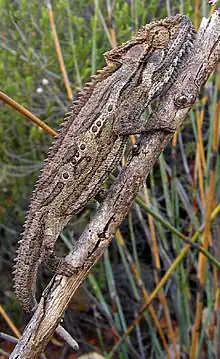 | |
| Robertson dwarf chameleon (Bradypodion gutturale) at Anysberg Nature Reserve | |
| Scientific classification | |
| Domain: | Eukaryota |
| Kingdom: | Animalia |
| Phylum: | Chordata |
| Class: | Reptilia |
| Order: | Squamata |
| Suborder: | Iguania |
| Family: | Chamaeleonidae |
| Subfamily: | Chamaeleoninae |
| Genus: | Bradypodion Fitzinger, 1843 |
| Type species | |
| Chamaeleo pumilus Daudin 1802 | |
| Diversity | |
| 20 species | |
Species
20 species are currently recognized:
| Image | Common Name | Scientific name | Distribution |
|---|---|---|---|
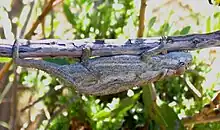 | Swartberg dwarf chameleon | B. atromontanum | Western Cape, South Africa |
| B. barbatulum | South Africa | ||
| B.baviaanense | South Africa | ||
_(46528288561).jpg.webp) | uMlalazi dwarf chameleon | B. caeruleogula | KwaZulu-Natal, South Africa. |
 | Transkei dwarf chameleon | B. caffrum | Eastern Cape Province of South Africa |
 | Knysna dwarf chameleon | B. damaranum | Knysna, South Africa |
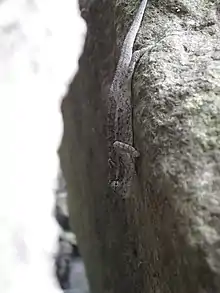 | Drakensberg dwarf chameleon | B. dracomontanum | Drakensberg, South Africa |
 | Robertson dwarf chameleon | B. gutturale (may be several species) | Western Cape province, South Africa. |
| Kentani dwarf chameleon | B. kentanicum | Eastern Cape, South Africa. | |
 | Black-headed dwarf chameleon | B. melanocephalum | KwaZulu-Natal, South Africa. |
 | Zululand dwarf chameleon | B. nemorale (probably several species) | South Africa. |
| Ngome dwarf chameleon | B. ngomeense | Ngome Forest, Kwa-Zulu Natal. | |
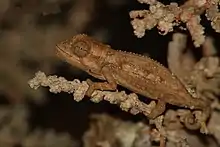 | Namaqua dwarf chameleon | B. occidentale | South Africa and Namibia. |
_male.jpg.webp) | Cape dwarf chameleon | B. pumilum | South African province of the Western Cape |
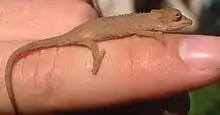 | Setaro's dwarf chameleon | B. setaroi | northern Kwazulu Natal, South Africa |
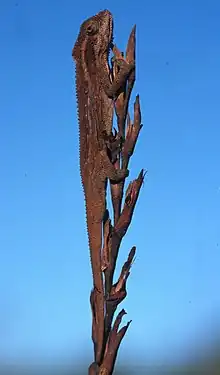 | Smith's dwarf chameleon | B. taeniabronchum | South Africa |
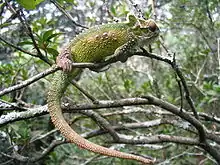 | Natal Midlands dwarf chameleon | B. thamnobates | South African province of KwaZulu-Natal. |
 | Transvaal dwarf chameleon | B. transvaalense | Mpumalanga and Limpopo provinces, South Africa |
 | Southern dwarf chameleon | B. ventrale | Eastern Cape, South Africa. |
| B. venustum | South Africa | ||
Undescribed species
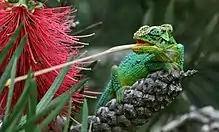
- Emerald dwarf chameleon, Bradypodion sp. (Emerald)
- Bradypodion sp. (Groendal)
- Bradypodion sp. (Grootvadersbosch)
- Bradypodion sp. (Jagersbos)
Systematics
Delimitation of Bradypodion has been controversial for some time. Most species seem readily distinguishable by morphological characteristics, but for some time the genus was used as a wastebin taxon for smaller chameleons from sub-Saharan Africa with plesiomorphic hemipenises.[1] Alternatively, many of the present species were reduced to subspecies status.[2] This has since been refuted,[3] but several more species seem recognizable judging from morphological[4] and mitochondrial 16S rRNA and NADH dehydrogenase subunit 2 sequence data.[5]
The phylogeny and biogeography of this group is quite consistently resolved. The Cape dwarf chameleon and the Knysna dwarf chameleon (and possibly one new species close to it) are basal lineages with unclear relationships; they seem a bit closer to each other than to any other species, but altogether are quite distant. They occur in isolated ranges in coastal Western Cape and western Eastern Cape provinces. Inhabiting a wide range of habitats, they are (for the genus) large, and have brilliant, predominantly green coloration and long tails - just as in many Chamaeleo. These characters are plesiomorphic, retained from the genus' ancestor.[5]
The remaining species form a well-supported clade, which in turn can be divided into smaller groups. One consists of forms that radiated on the seawards slopes of the Drakensberg Mountains: the southern Drakensberg dwarf chameleon, the northern Transvaal dwarf chameleon, and what appears to be undescribed species from the Ngome Forest on the southeastern slopes. These are also plesiomorphic in habitus and habits.[5]
Another group of taxa occurs from easternmost Eastern Cape to central KwaZulu-Natal provinces, between Gilboa Forest and the Tugela River. These inhabit a wide range of habitat and contain the plesiomorphic Natal Midlands dwarf chameleon from the namesake region, the small black-headed dwarf chameleon which inhabits fynbos and other low forest on slopes of mainly coastal KwaZulu-Natal, and another probable new species from the Gilboa Forest area. These appear to be a quite recent radiation from a single ancestor, and the group requires more research as regards species limits, and geographical delimitation from the Drakensberg dwarf chameleon.[5]
Several largish but short-tailed and cryptic taxa inhabit more arid habitats such as karoo. The Karroo and southern dwarf chameleons seem to have considerable gene flow range from Northern Cape to coastal Eastern Cape provinces. The small and nearly extinct Smith's dwarf chameleon is close to these; it occurs on the escarpment inland from Jeffreys Bay. Less closely related is the Robertson dwarf chameleon, another aridland species which is found in Western Cape province inland from the range of the Cape dwarf chameleon and may be a cryptic species complex, and an undescribed population from the Swartberg Mountains.[6] The last species with aridland apomorphies, the Namaqua dwarf chameleon, is quite distant to the others; it occurs in coastal regions from north of the Cape species through Namaqualand. This is probably still a part of a single radiation which brought about all the aridland taxa, and eventually Smith's dwarf chameleon.[5]
The remaining species are all small inhabitants of forested slopes and fynbos, such as the black-headed and Smith's dwarf chameleons. However, as already indicated by the distinctness of these two, their morphologies seem to be a convergent adaptation. The Kentani and Transkei dwarf chameleons from the east coasts of Eastern Cape may or may not be each other's closest relatives. Setaro's dwarf chameleon from northeastern coastal KwaZulu-Natal is not close to these. The Zululand dwarf chameleon from western uThungulu apparently consists of two or more species, one that may be closer to the preceding, and one that might be an early offshoot of the ancestral Drakensberg stock, and which are distinguishable by morphological and mtDNA characteristics.[7]
In conclusion, of the three basic morphotypes found in this genus, one (bright, long-tailed, large) is plesiomorphic, another (large, short-tailed, drab) apparently only evolved once, and the third (the small, slope-inhabiting forms) are convergent in morphology. The ancestors of Bradypodion thus were mid-sized chameleons with vivid color, which settled the Cape region from roughly north-northwestwards. Due to climate changes with fluctuating aridity, the basal lineages inhabiting humid fynbos in the southwest became isolated from each other and from the animals living around the border region between Northern and Eastern Cape and Free State, and Lesotho. The aridland habitat fluctuates in extent during climate shifts, and mountainous habitat becomes fragmented or consolidates accordingly. Consequently, the Drakensberg, the B. thamnobates-B. melanocephalum, and the aridland group, as well as several coastal lineages, diverged and evolved to their present-day ranges and diversity.[5]
Footnotes
- Klaver & Böhme (1986), Branch (1998)
- Klaver & Böhme (1997)
- Branch (1998), Tolley et al. (2004)
- Raw (2001)
- Tolley et al. (2004)
- Branch (1998): plate 1, Tolley et al. (2004)
- Raw (2001), Tolley et al. (2004)
References
- Branch, W.R. (1998): Field Guide to Snakes and Other Reptiles of Southern Africa. Struik Publishers Ltd, Cape Town (revised edition).
- Klaver, C.J.J. & Böhme, W. (1986): Phylogeny and classification of the Chamaeleonidae (Sauria) with special reference to hemipenis morphology. Bonner Zoologische Monographien 22: 1–64.
- Klaver, C.J.J. & Böhme, W. (1997): Liste der rezenten Amphibien und Reptilien - Chamaeleonidae. Das Tierreich 112: i-xiv, 1-85.
- Tolley, Krystal A.; Tilbury, Colin R.; Branch, William R. & Matthee, Conrad A. (2004): Phylogenetics of the southern African dwarf chameleons, Bradypodion (Squamata: Chamaeleonidae). Molecular Phylogenetics and Evolution 30: 354–365. doi:10.1016/S1055-7903(03)00211-2 PDF fulltext